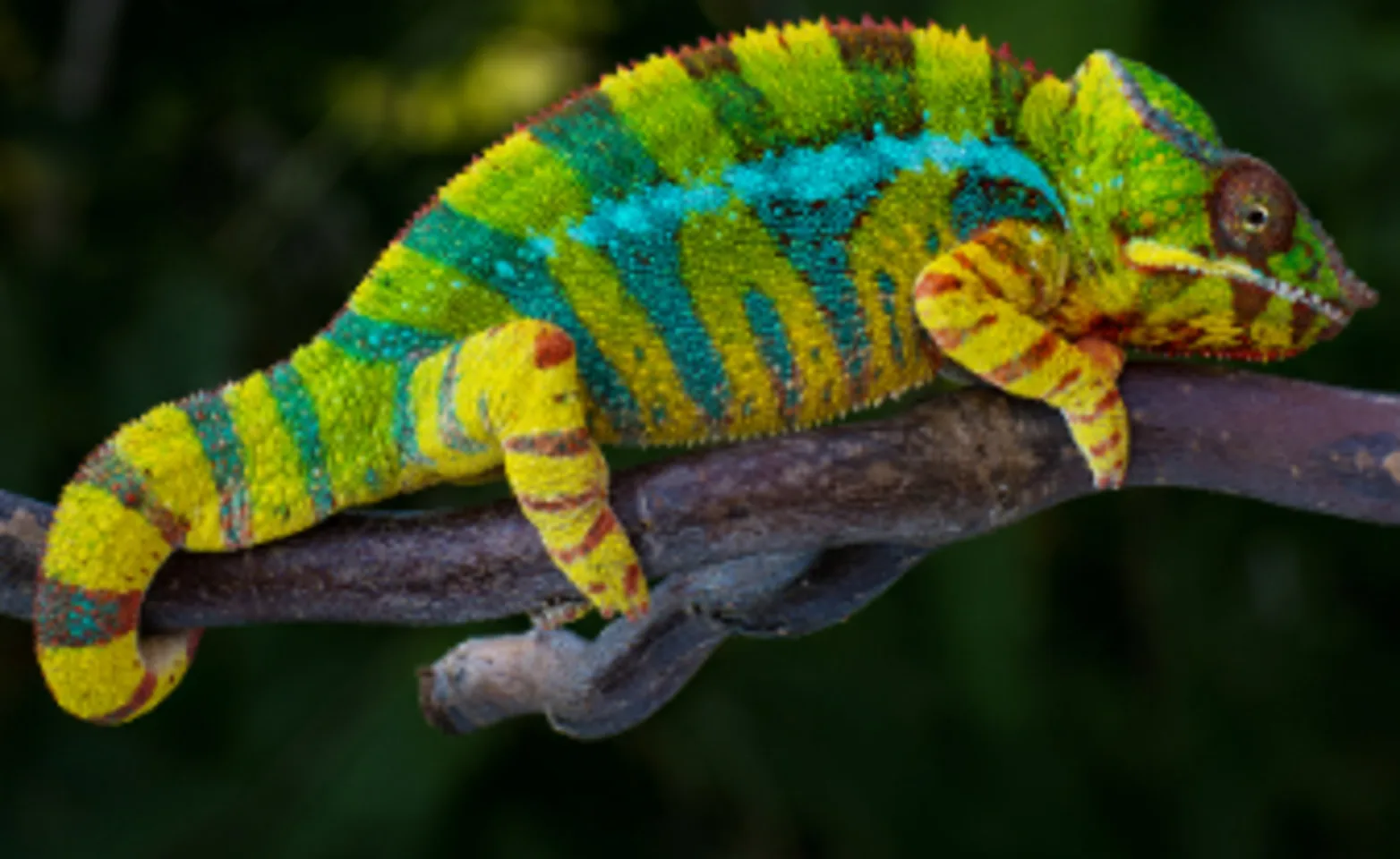Warren Woods Veterinary Hospital

Chameleons Husbandry and Care
Chameleons are arboreal lizards that originate from Africa, Madagascar, Spain, Portugal, across Asia and Sri Lanka depending on the species. More common captive species of chameleons include Veiled, Jackson, Panther and Senegal. Chameleons are recognized by their parrot like feet, their large independently moving eyes, long tongues, prehensile tails and the ability to change color.
A chameleon’s tongue is approximately 1 to 1 and 1/2 times the length of its body. It extends very rapidly, reaching its full extension in 1/16th of a second. Chameleons change colors depending on the light, their temperament and their mood. For example a stressed, cold or sick chameleon will appear darker in color. Chameleons appear brighter and more colorful when trying to ward off threats or attract a mate. Chameleons can range in size from 6-24 inches depending on the species. They are very territorial and should be housed alone. They live an average of 3-5 years in captivity.
Chameleons are very fragile reptiles and get stressed easily. Their cage should be kept in a quiet part of the house with minimal commotion. Chameleons should not be frequently handled. When holding your chameleon be very gentle and careful to not squeeze or apply a lot of pressure to your chameleon’s body; carefully and slowly scoop your chameleon from the underside. Ensure your chameleon does not fall as this can be fatal. It is also important to thoroughly wash your hands after handling.
Chameleons need a large enclosure with good ventilation. The enclosure should be a minimum of 2 feet by 2 feet by 4 feet tall. A cage made of a poly mesh or vinyl coated wire is preferred for adequate ventilation. Since chameleons are arboreal, meaning they live mostly in trees, numerous branches and vines of different diameters should be offered in the enclosure. Safe live plants include pothos, hibiscus, geranium and dracaena. Cleanliness of the enclosure is vital to prevent bacterial or mold growth. The cage can be cleaned as needed with a mild soap and water, making sure to thoroughly rinse the cage.
A heat lamp, ceramic heat emitter is important to maintain the appropriate temperature. The ideal temperature for a chameleon will vary based on the species but is usually between 75-90 degrees Fahrenheit. The temperature is monitored with a thermometer. Your chameleon should have 12 hours of daylight (white light) and 12 hours of darkness for its natural biorhythms. A timer purchased from a pet supply store or hardware store can be utilized to maintain this twelve hour light cycle. At night, the temperature in the enclosure should drop slightly, about 10 degrees, as it would in their natural habitat. Night temperatures should also be closely monitored and ceramic heat emitters, red, blue or purple reptile night bulbs can aid in increasing night temperatures if needed. Always use reptile specific heat bulbs which have modifications that benefit the reptile and helps stimulates eating.
An ultraviolet light is essential for the health of chameleons. This reptile specific bulb produces UVA and UVB rays and is purchased from your local pet supply store. The UVB rays are important for the natural production of vitamin D which helps the chameleon absorb calcium from its diet. Without the UV bulb your chameleon cannot properly absorb calcium which leads to metabolic bone disease. UV bulbs for reptiles come in two different forms the compact (coil) bulb and the linear florescent tube. While there are many companies that produce UV bulbs, Zoo Med and Zilla are recommended. Follow manufacturer recommendations to determine the type of UV bulb you purchase, and the distance to place the bulb from your chameleon. All UV bulbs need to be changed every 6-12 months based on manufacturer’s recommendations. After that time, even if the bulb still turns on it is not producing the vital rays your chameleon needs for calcium metabolism. Plastic and glass windows are designed to block UVB rays so keeping the enclosure by a window will not provide essential UVB rays. It is ideal to provide monitored time outside on a warm day in an escape proof enclosure with access to shelter. Natural sunlight is the best source of essential UV rays.
Chameleons require a specific level of humidity which is monitored with the aid of a hydrometer purchased at your local pet supply store. The humidity level will vary depending on species and is usually 30-80%. Maintaining the proper level can be carried out by installing a waterfall in the enclosure, misting system or fogging system. The enclosure should also be misted several times daily with a spray bottle or power mister on the gentlest setting. Be sure not to spray your chameleon directly. Misting is important since chameleons will not recognize standing water as a water source. In the wild chameleons drink water droplets off leaves; your chameleon will drink the droplets off the foliage in the enclosure. A drip system purchased at your local pet store can also be installed to provide a constant source of water droplets for your chameleon to drink.
Chameleons are insectivores and eat a variety of bugs. Their staple diet is crickets but it is important to offer other insects, for variety. Safe foods include gut loaded crickets, mealworms, hornworms, butterworms, locusts, silkworms, flies, grasshoppers and roaches. Wax worms can be fatting and super worms are hard to digest so these should be offered more as treats. Insects should be gut loaded which means that they were fed nutritious foods before being fed to your chameleon. Gut loading insect food is available at your local pet supply store. Only put enough live food in the cage as your chameleon will eat at a time because an insect in the cage will get hungry and munch on your chameleon. Insects should not be larger then ½ to ¾ the size of the space between your chameleon’s eyes, large food may cause your chameleon to choke. Your chameleon should never be fed bugs found outside as these run the risk of being contaminated with parasites, pesticides and diseases. The best time to feed your chameleon is in the morning after having a few hours to warm up.
Chameleons do not produce enough calcium themselves and therefore it must be supplemented in their food. This can be done by purchasing a calcium D3 powder from your local area pet store. This powder is sprinkled on food 3-4 times a week for juvenile chameleons (under one year old) or breeding females and 2-3 times a week for adult chameleons. It can be applied to live food by placing the insects and powder in a bag and lightly shaking.
An annual examination with a qualified veterinarian is important to ensure your chameleon is in good health. Chameleons are very good at hiding when they are sick; this is an instinctive behavior. It is very important to see a qualified veterinarian as soon as you notice your chameleon acting abnormal. Common conditions of chameleons include dehydration, metabolic bone disease, parasites, respiratory infections, kidney failure, egg binding, and anorexia.
